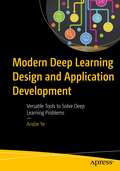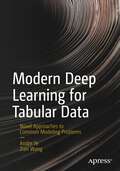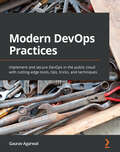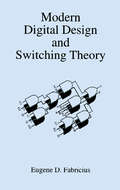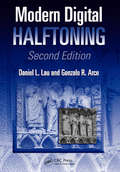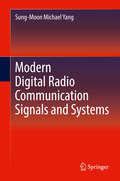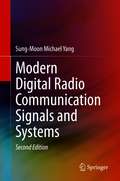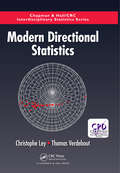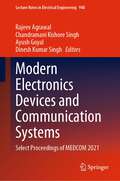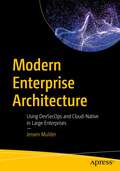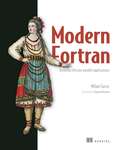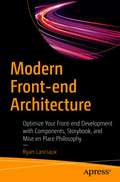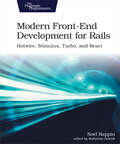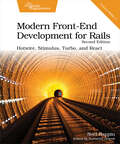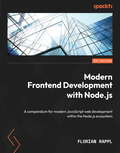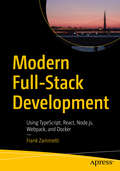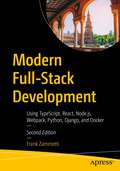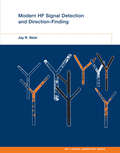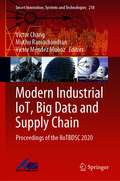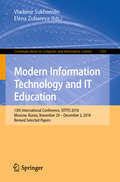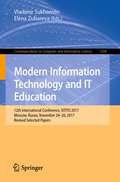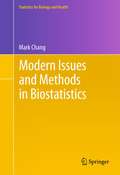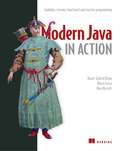- Table View
- List View
Modern Deep Learning Design and Application Development: Versatile Tools to Solve Deep Learning Problems
by Andre YeLearn how to harness modern deep-learning methods in many contexts. Packed with intuitive theory, practical implementation methods, and deep-learning case studies, this book reveals how to acquire the tools you need to design and implement like a deep-learning architect. It covers tools deep learning engineers can use in a wide range of fields, from biology to computer vision to business. With nine in-depth case studies, this book will ground you in creative, real-world deep learning thinking. You’ll begin with a structured guide to using Keras, with helpful tips and best practices for making the most of the framework. Next, you’ll learn how to train models effectively with transfer learning and self-supervised pre-training. You will then learn how to use a variety of model compressions for practical usage. Lastly, you will learn how to design successful neural network architectures and creatively reframe difficult problems into solvable ones. You’ll learn not only to understand and apply methods successfully but to think critically about it. Modern Deep Learning Design and Methods is ideal for readers looking to utilize modern, flexible, and creative deep-learning design and methods. Get ready to design and implement innovative deep-learning solutions to today’s difficult problems. What You’ll Learn Improve the performance of deep learning models by using pre-trained models, extracting rich features, and automating optimization.Compress deep learning models while maintaining performance. Reframe a wide variety of difficult problems and design effective deep learning solutions to solve them. Use the Keras framework, with some help from libraries like HyperOpt, TensorFlow, and PyTorch, to implement a wide variety of deep learning approaches. Who This Book Is For Data scientists with some familiarity with deep learning to deep learning engineers seeking structured inspiration and direction on their next project. Developers interested in harnessing modern deep learning methods to solve a variety of difficult problems.
Modern Deep Learning for Tabular Data: Novel Approaches to Common Modeling Problems
by Andre Ye Zian WangDeep learning is one of the most powerful tools in the modern artificial intelligence landscape. While having been predominantly applied to highly specialized image, text, and signal datasets, this book synthesizes and presents novel deep learning approaches to a seemingly unlikely domain – tabular data. Whether for finance, business, security, medicine, or countless other domain, deep learning can help mine and model complex patterns in tabular data – an incredibly ubiquitous form of structured data. Part I of the book offers a rigorous overview of machine learning principles, algorithms, and implementation skills relevant to holistically modeling and manipulating tabular data. Part II studies five dominant deep learning model designs – Artificial Neural Networks, Convolutional Neural Networks, Recurrent Neural Networks, Attention and Transformers, and Tree-Rooted Networks – through both their ‘default’ usage and their application to tabular data. Part III compounds the power of the previously covered methods by surveying strategies and techniques to supercharge deep learning systems: autoencoders, deep data generation, meta-optimization, multi-model arrangement, and neural network interpretability. Each chapter comes with extensive visualization, code, and relevant research coverage. Modern Deep Learning for Tabular Data is one of the first of its kind – a wide exploration of deep learning theory and applications to tabular data, integrating and documenting novel methods and techniques in the field. This book provides a strong conceptual and theoretical toolkit to approach challenging tabular data problems.What You Will LearnImportant concepts and developments in modern machine learning and deep learning, with a strong emphasis on tabular data applications.Understand the promising links between deep learning and tabular data, and when a deep learning approach is or isn’t appropriate.Apply promising research and unique modeling approaches in real-world data contexts.Explore and engage with modern, research-backed theoretical advances on deep tabular modelingUtilize unique and successful preprocessing methods to prepare tabular data for successful modelling. Who This Book Is ForData scientists and researchers of all levels from beginner to advanced looking to level up results on tabular data with deep learning or to understand the theoretical and practical aspects of deep tabular modeling research. Applicable to readers seeking to apply deep learning to all sorts of complex tabular data contexts, including business, finance, medicine, education, and security.
Modern DevOps Practices: Implement and secure DevOps in the public cloud with cutting-edge tools, tips, tricks, and techniques
by Gaurav AgarwalEnhance DevOps workflows by integrating the functionalities of Docker, Kubernetes, Spinnaker, Ansible, Terraform, Flux CD, CaaS, and more with the help of practical examples and expert tipsKey FeaturesGet up and running with containerization-as-a-service and infrastructure automation in the public cloudLearn container security techniques and secret management with Cloud KMS, Anchore Grype, and Grafeas KritisLeverage the combination of DevOps, GitOps, and automation to continuously ship a package of softwareBook DescriptionContainers have entirely changed how developers and end-users see applications as a whole. With this book, you'll learn all about containers, their architecture and benefits, and how to implement them within your development lifecycle.You'll discover how you can transition from the traditional world of virtual machines and adopt modern ways of using DevOps to ship a package of software continuously. Starting with a quick refresher on the core concepts of containers, you'll move on to study the architectural concepts to implement modern ways of application development. You'll cover topics around Docker, Kubernetes, Ansible, Terraform, Packer, and other similar tools that will help you to build a base. As you advance, the book covers the core elements of cloud integration (AWS ECS, GKE, and other CaaS services), continuous integration, and continuous delivery (GitHub actions, Jenkins, and Spinnaker) to help you understand the essence of container management and delivery. The later sections of the book will take you through container pipeline security and GitOps (Flux CD and Terraform).By the end of this DevOps book, you'll have learned best practices for automating your development lifecycle and making the most of containers, infrastructure automation, and CaaS, and be ready to develop applications using modern tools and techniques.What you will learnBecome well-versed with AWS ECS, Google Cloud Run, and KnativeDiscover how to build and manage secure Docker images efficientlyUnderstand continuous integration with Jenkins on Kubernetes and GitHub actionsGet to grips with using Spinnaker for continuous deployment/deliveryManage immutable infrastructure on the cloud with Packer, Terraform, and AnsibleExplore the world of GitOps with GitHub actions, Terraform, and Flux CDWho this book is forIf you are a software engineer, system administrator, or operations engineer looking to step into the world of DevOps within public cloud platforms, this book is for you. Existing DevOps engineers will also find this book useful as it covers best practices, tips, and tricks to implement DevOps with a cloud-native mindset. Although no containerization experience is necessary, a basic understanding of the software development life cycle and delivery will help you get the most out of the book.
Modern Digital Design and Switching Theory
by Eugene D. FabriciusModern Digital Design and Switching Theory is an important text that focuses on promoting an understanding of digital logic and the computer programs used in the minimization of logic expressions. Several computer approaches are explained at an elementary level, including the Quine-McCluskey method as applied to single and multiple output functions, the Shannon expansion approach to multilevel logic, the Directed Search Algorithm, and the method of Consensus. Chapters 9 and 10 offer an introduction to current research in field programmable devices and multilevel logic synthesis. Chapter 9 covers more advanced topics in programmed logic devices, including techniques for input decoding and Field-Programmable Gate Arrays (FPGAs). Chapter 10 includes a discussion of boolean division, kernels and factoring, boolean tree structures, rectangle covering, binary decision diagrams, and if-then-else operators. Computer algorithms covered in these two chapters include weak division, iterative weak division, and kernel extraction by tabular methods and by rectangle covering theory. Modern Digital Design and Switching Theory is an excellent textbook for electrical and computer engineering students, in addition to a worthwhile reference for professionals working with integrated circuits.
Modern Digital Halftoning (Signal Processing and Communications #1)
by Daniel L. Lau Gonzalo R. ArceThe late 1980s, revolutionary advances in digital halftoning enabled inkjet printers to achieve much higher image fidelity. The rapid rate of progress has resulted in numerous breakthroughs scattered throughout the literature, rendering old technologies obsolete and renewing the need for a centralized source on the current state of the art. Entirely revised and updated, Modern Digital Halftoning, Second Edition provides an integrated and up-to-date treatment of stochastic halftoning and digital printing. Using full-color illustrations to enhance the text, this edition incorporates new topics as well as updated models, algorithms, and methods used to construct and improve the quality of green-noise, blue-noise, and multitone images. Following a review of various halftoning techniques, this edition now covers amplitude modulated dither arrays, adapting to human visual models, direct binary search, and handling stochastic moiré problems. It also presents a new chapter on lenticular printing, a means for printing color holographic images. Accompanying downloadable resources contain MATLAB® software files and illustrated examples employing algorithms, statistics, and other key concepts from the book. Documenting the development of digital printing since the first edition, Modern Digital Halftoning, Second Edition offers a well-rounded and accurate perspective on the technological capabilities of digital printing and provides all the necessary tools for continuing research in the field.
Modern Digital Radio Communication Signals and Systems
by Sung-Moon Michael YangThis book serves as an easily accessible reference for wireless digital communication systems. Topics are presented with simple but non-trivial examples and then elaborated with their variations and sophistications. It includes numerous examples and exercises to illustrate key points. The book emphasizes both practical problem solving and a thorough understanding of fundamentals, aiming to realize the complementary relationship between practice and theory. Though the author emphasize wireless radio channels, the fundamentals that are covered are useful to different channels - digital subscriber line, coax, power lines, optical fibers, and even Gigabit serial interconnection. This book is the outgrowth of the author’s hands-on experience in the telecommunication systems industry as a research and development engineer. It is written primarily for practitioners of wireless digital communication systems – engineers and technical leaders and managers – and for digital communication systems in general including new comers like graduate students and upper-division undergraduate students. The material in chapters 5(OFDM), 6(Channel coding), 7(Synchronization) and 8(Transceivers) contains something new, not explicitly available in typical textbooks, and useful in practice. For example, in Chapter 5, all known orthogonal frequency division multiplex signals are formulated based on pulse shape and thus flexible, e.g., unlike currently predominant symbol block transmission, it can be serial transmission. In Chapter 6, we emphasize practical applications of powerful error coding such as LDPC to higher order modulations, fading, and non-linearity problem. In Chapter 7, new digital timing detectors are suggested for small access bandwidth shaping pulse, and a digital quadrature imbalance correction is also included along with digital carrier phase recovery. In Chapter 8, low IF digital image cancelling transceiver is treated in detail so that practical implementation can be readily done with advantages.
Modern Digital Radio Communication Signals and Systems
by Sung-Moon Michael YangThis book serves as an easily accessible reference for wireless digital communication systems. Topics are presented with simple but non-trivial examples and then elaborated with their variations and sophistications. The book includes numerous examples and exercises to illustrate key points. For this new edition, a set of problems at the end of each chapter is added, for a total of 298 problems. The book emphasizes both practical problem solving and a thorough understanding of fundamentals, aiming to realize the complementary relationship between practice and theory. Though the author emphasizes wireless radio channels, the fundamentals that are covered here are useful to different channels - digital subscriber line, coax, power lines, optical fibers, and even Gigabit serial connections. The material in chapters 5 (OFDM), 6 (Channel coding), 7 (Synchronization), and 8 (Transceivers) contains new and updated information, not explicitly available in typical textbooks, and useful in practice. For example, in chapter 5, all known orthogonal frequency division multiplex signals are derived from its digitized analog FDM counterparts. Thus, it is flexible to have different pulse shape for subcarriers, and it can be serial transmission as well as block transmission. Currently predominant cyclic prefix based OFDM is a block transmission using rectangular pulse in time domain. This flexibility may be useful in certain applications. For additional information, consult the book support website: https://baycorewireless.com
Modern Directional Statistics: Modern Methods And Case Studies (Chapman & Hall/CRC Interdisciplinary Statistics)
by Christophe Ley Thomas VerdeboutModern Directional Statistics collects important advances in methodology and theory for directional statistics over the last two decades. It provides a detailed overview and analysis of recent results that can help both researchers and practitioners. Knowledge of multivariate statistics eases the reading but is not mandatory. <P><P> The field of directional statistics has received a lot of attention over the past two decades, due to new demands from domains such as life sciences or machine learning, to the availability of massive data sets requiring adapted statistical techniques, and to technological advances. This book covers important progresses in distribution theory,high-dimensional statistics, kernel density estimation, efficient inference on directional supports, and computational and graphical methods. <P><P>Christophe Ley is professor of mathematical statistics at Ghent University. His research interests include semi-parametrically efficient inference, flexible modeling, directional statistics and the study of asymptotic approximations via Stein’s Method. His achievements include the Marie-Jeanne Laurent-Duhamel prize of the Société Française de Statistique and an elected membership at the International Statistical Institute. He is associate editor for the journals Computational Statistics & Data Analysis and Econometrics and Statistics. <P><P> Thomas Verdebout is professor of mathematical statistics at Université libre de Bruxelles (ULB). His main research interests are semi-parametric statistics, high- dimensional statistics, directional statistics and rank-based procedures. He has won an annual prize of the Belgian Academy of Sciences and is an elected member of the International Statistical Institute. He is associate editor for the journals Statistics and Probability Letters and Journal of Multivariate Analysis.
Modern Electronics Devices and Communication Systems: Select Proceedings of MEDCOM 2021 (Lecture Notes in Electrical Engineering #948)
by Dinesh Kumar Singh Rajeev Agrawal Chandramani Kishore Singh Ayush GoyalThis book presents select and peer-reviewed proceedings of the International Conference on Smart Communication and Imaging Systems (MEDCOM 2021). The contents explore the recent technological advances in the field of next-generation electronics devices and communication systems. The topics include the design and development of smart, secure, and reliable future communication networks; satellite, radar, and microwave techniques for intelligent communication. The book also covers methods and applications of GIS and remote sensing; medical image analysis and its applications in smart health. This book can be useful for students, researchers, and professionals working in the field of communication systems and image processing.
Modern Enterprise Architecture: Using DevSecOps and Cloud-Native in Large Enterprises
by Jeroen MulderEnterprise Architecture (EA) frameworks such as TOGAF and Zachman are still valid, but enterprise architects also need to adapt to the new reality of agile, DevOps, and overall disruption through digital transformation. This book will help do just that. The Change to Modern Enterprise Architecture will teach you how to use known frameworks in the new world of digital transformation. Over the course of the book, you'll learn how modern EA is helping drive strategic business decisions, create continuous and agile (“floating”) architecture for scalability, and how to address quality and speed in architecture using and integrating DevSecOps frameworks in EA. This book is divided into three parts: the first explains what modern enterprise architecture is and why it’s important to any business. It covers the different EA frameworks and explains what they are. In the second part, you will learn how to integrate modern development frameworks into EA, and why this knowledge will enable you to deftly respond to various business challenges. The final section of the book is all about scaling the enterprise using modern enterprise architecture. You will also see how the role of the enterprise architect is changing and how to remain in control of your architecture. Upon completing this book, you'll understand why the enterprise architect is no longer just a role overseeing the architecture strategy of a business, but has become more of a leader in driving engineering excellence. What You'll Learn Integrate DevSecOps as artifact to modern EAUse Enterprise Architecture to scale up your businessUnderstand the changing role of the enterprise architectDefine a floating architecture to enhance business agility Who This Book Is For Enterprise architects, IT architects, lead engineers, business architects, business leaders, product managers.
Modern Fortran: style and usage
by Norman S. Clerman Walter SpectorFortran is one of the oldest high-level languages and remains the premier language for writing code for science and engineering applications. Modern Fortran: Style and Usage is a book for anyone who uses Fortran, from the novice learner to the advanced expert. It describes best practices for programmers, scientists, engineers, computer scientists, and researchers who want to apply good style and incorporate rigorous usage in their own Fortran code or to establish guidelines for a team project. The presentation concentrates primarily on the characteristics of Fortran 2003, while also describing methods in Fortran 90/95 and valuable new features in Fortran 2008. The authors draw on more than a half century of experience writing production Fortran code to present clear succinct guidelines on formatting, naming, documenting, programming, and packaging conventions and various programming paradigms such as parallel processing (including OpenMP, MPI, and coarrays), OOP, generic programming, and C language interoperability. Programmers working with legacy code will especially appreciate the section on updating old programs.
Modern Fortran: Building efficient parallel applications
by Milan CurcicModern Fortran teaches you to develop fast, efficient parallel applications using twenty-first-century Fortran. In this guide, you&’ll dive into Fortran by creating fun apps, including a tsunami simulator and a stock price analyzer. Filled with real-world use cases, insightful illustrations, and hands-on exercises, Modern Fortran helps you see this classic language in a whole new light.Summary Using Fortran, early and accurate forecasts for hurricanes and other major storms have saved thousands of lives. Better designs for ships, planes, and automobiles have made travel safer, more efficient, and less expensive than ever before. Using Fortran, low-level machine learning and deep learning libraries provide incredibly easy, fast, and insightful analysis of massive data. Fortran is an amazingly powerful and flexible programming language that forms the foundation of high performance computing for research, science, and industry. And it's come a long, long way since starting life on IBM mainframes in 1956. Modern Fortran is natively parallel, so it's uniquely suited for efficiently handling problems like complex simulations, long-range predictions, and ultra-precise designs. If you're working on tasks where speed, accuracy, and efficiency matter, it's time to discover—or re-discover—Fortran.. About the technology For over 60 years Fortran has been powering mission-critical scientific applications, and it isn't slowing down yet! Rock-solid reliability and new support for parallel programming make Fortran an essential language for next-generation high-performance computing. Simply put, the future is in parallel, and Fortran is already there. Purchase of the print book includes a free eBook in PDF, Kindle, and ePub formats from Manning Publications. About the book Modern Fortran teaches you to develop fast, efficient parallel applications using twenty-first-century Fortran. In this guide, you'll dive into Fortran by creating fun apps, including a tsunami simulator and a stock price analyzer. Filled with real-world use cases, insightful illustrations, and hands-on exercises, Modern Fortran helps you see this classic language in a whole new light. What's inside Fortran's place in the modern world Working with variables, arrays, and functions Module development Parallelism with coarrays, teams, and events Interoperating Fortran with C About the reader For developers and computational scientists. No experience with Fortran required. About the author Milan Curcic is a meteorologist, oceanographer, and author of several general-purpose Fortran libraries and applications. Table of Contents PART 1 - GETTING STARTED WITH MODERN FORTRAN 1 Introducing Fortran 2 Getting started: Minimal working app PART 2 - CORE ELEMENTS OF FORTRAN 3 Writing reusable code with functions and subroutines 4 Organizing your Fortran code using modules 5 Analyzing time series data with arrays 6 Reading, writing, and formatting your data PART 3 - ADVANCED FORTRAN USE 7 Going parallel with Fortan coarrays 8 Working with abstract data using derived types 9 Generic procedures and operators for any data type 10 User-defined operators for derived types PART 4 - THE FINAL STRETCH 11 Interoperability with C: Exposing your app to the web 12 Advanced parallelism with teams, events, and collectives
Modern Fortran in Practice
by Arjen MarkusFrom its earliest days, the Fortran programming language has been designed with computing efficiency in mind. The latest standard, Fortran 2008, incorporates a host of modern features, including object-orientation, array operations, user-defined types, and provisions for parallel computing. This tutorial guide shows Fortran programmers how to apply these features in twenty-first-century style: modular, concise, object-oriented, and resource-efficient, using multiple processors. It offers practical real-world examples of interfacing to C, memory management, graphics and GUIs, and parallel computing using MPI, OpenMP, and coarrays. The author also analyzes several numerical algorithms and their implementations and illustrates the use of several open source libraries. Full source code for the examples is available on the book's Web site.
Modern Front-end Architecture: Optimize Your Front-end Development with Components, Storybook, and Mise en Place Philosophy
by Ryan LanciauxLearn how to build front-end applications that can help you ship applications faster with fewer defects. Many software projects fail because they are not planned well, or lack organization. Applying strategies from other industries can help you create better software. This book explores the “mise en place” technique from cooking and reveals how you can apply it to the art of creating software.In many professional kitchens, the work of preparing a meal is divided and performed in workstations to help create the whole. You'll review the philosophy behind this and see how to leverage this approach in your code. You'll also learn to visualize your applications as a series of components and build parts of your application in isolation - just like a professional chef crafting each part of the meal.The book describes to how to structure your code base for reuse, and how to communicate the code’s intent to other developers. You’ll develop your components in isolation and test these building blocks for quality at a granular level. Then compose these components as building blocks in increasingly complicated features. Finally, you’ll apply some strategies not directly related to code to ensure maximum quality and efficiency.With Modern Front-end Architecture, developers of all levels will learn strategies that they and their teams can leverage to be more productive. What You'll LearnStructure an application as a series of componentsBuild a component library that others in an organization can leverageEnsure quality and accessibility at a component level rather than a page or app levelTest code in a way that gives the maximum amount of confidence while providing an excellent developer experienceAutomate repeatable tasksWho This Book Is For Front end developers looking to maximize their code for reuse, quality, and shipping features quickly. Experienced developers will pick up new techniques that they can apply to their code base. Less experienced developers will be able to start applications off on the right foot.
Modern Front-End Development for Rails: Hotwire, Stimulus, Turbo, And React
by Noel RappinImprove the user experience for your Rails app with rich, engaging client-side interactions. Learn to use the Rails 6 tools and simplify the complex JavaScript ecosystem. It's easier than ever to build user interactions with the Webpacker gem and Stimulus. You can add great front-end flair without much extra complication. Add React to build an even more extensive set of client-side features. Structure your code for different levels of client-side needs with these powerful options. Add to your toolkit today!It's hard to have a Rails application without integrating some client-side logic. But client-side coding tools, and the Rails tools for integrating with them, all change continuously. Rails 6 simplifies client-side integration with the Webpacker gem. It's the default tool for building client-side assets for use by web browsers. Learn how to use Rails 6 and Webpacker to build rich front-end logic into your Rails applications. The job is even easier with Stimulus, a library that brings Rails conventions to JavaScript tools. Add in some React, a popular framework that automatically updates the browser when your data changes.Learn the basics of webpack, Webpacker, and TypeScript, and add pizazz to your application. Structure your web application to best manage your state. Learn how to interact with data on the server while still keeping the user experience interactive. Use the type system in TypeScript to expand on JavaScript and help prevent error conditions. Debug and test your front-end application with tools specific to each framework.There are a lot of ways to do client-side coding, and Rails is here to help.What You Need:This book requires Ruby on Rails 6.0+, React 16.8.0+. Other dependencies will be added by Rails.
Modern Front-End Development for Rails
by Noel RappinImprove the user experience for your Rails app with rich, engaging client-side interactions. Learn to use the Rails 7 tools and simplify the complex JavaScript ecosystem. It's easier than ever to build user interactions with Hotwire, Turbo, and Stimulus. You can add great front-end flair without much extra complication. Use React to build a more complex set of client-side features. Structure your code for different levels of client-side needs with these powerful options. Add to your toolkit today! It's hard to have a Rails application without integrating some client-side logic. But client-side coding tools, and the Rails tools for integrating with them, all change continuously. Rails 7 simplifies client-side integration with the Hotwire gem. It's a great way to build client interaction with server-side HTML and a small amount of JavaScript. In the latest edition of this book, learn how to use Rails 7 and its front-end bundling tools to build rich front-end logic into your Rails applications. The job is even easier with Stimulus, a library that brings Rails conventions to JavaScript tools. And you can also add in React, a larger framework that automatically updates the browser when your data changes. Learn the basics of Turbo, Stimulus, and TypeScript, and add pizazz to your application. Structure your web application to best manage your state. Learn how to interact with data on the server while still keeping the user experience interactive. Use the type system in TypeScript to expand on JavaScript and help prevent error conditions. Debug and test your front-end application with tools specific to each framework. There are a lot of ways to do client-side coding, and Rails is here to help. What You Need: This book requires Ruby on Rails 7.0 or later, React 17.0.0 or later. Other dependencies will be added by Rails.
Modern Frontend Development with Node.js: A compendium for modern JavaScript web development within the Node.js ecosystem
by Florian RapplEnhance your web development projects by fully leveraging Node.js concepts, tools, and best practices at frontendKey FeaturesDiscover the internals of Node.js, focusing on frontend web developmentExplore the npm frontend ecosystem, including its tooling, usage, and development processesLearn about key web development concepts such as monorepos or publishing librariesBook DescriptionAlmost a decade after the release of Node.js, the tooling used by frontend developers is fully embracing this cross-platform JavaScript runtime, which is sadly often limited to server-side web development. This is where this Node.js book comes in, showing you what this popular runtime has to offer and how you can unlock its full potential to create frontend-focused web apps.You'll begin by learning the basics and internals of Node.js, before discovering how to divide your code into modules and packages. Next, you'll get to grips with the most popular package managers and their uses and find out how to use TypeScript and other JavaScript variants with Node.js. Knowing which tool to use when is crucial, so this book helps you understand all the available state-of-the-art tools in Node.js. You'll interact with linters such as ESLint and formatters such as Prettier. As you advance, you'll become well-versed with the Swiss Army Knife for frontend developers – the bundler. You'll also explore various testing utilities, such as Jest, for code quality verification. Finally, you'll be able to publish your code in reusable packages with ease.By the end of this web development book, you'll have gained the knowledge to confidently choose the right code structure for your repositories with all that you've learned about monorepos.What you will learnDevelop a frontend application with Node.js-based tools and librariesUse bundlers such as webpack or Vite to create efficient web applicationsLeverage test runners such as Jest to ship reliable softwareOrganize code repositories to work in close collaboration with other developers and teamsFind out how to publish npm packages to simplify code reuseImprove code quality by enabling consistent formatting using PrettierWho this book is forThis book is for junior and intermediate-level frontend web developers who are looking to leverage the Node.js ecosystem for building frontend solutions. The book requires beginner-level knowledge of JavaScript, HTML, and CSS. Prior experience in using a standard shell (sh) will be beneficial.
Modern Full-Stack Development: Using TypeScript, React, Node.js, Webpack, and Docker
by Frank ZammettiExplore what React, Node, TypeScript, Webpack, and Docker have to offer individually, and how they all fit together in modern app development. React is one of the most popular web development tools available today, and Node.js is extremely popular for server-side development. The fact that both utilize JavaScript is a big selling point, but as developers use the language more, they begin to recognize the shortcomings, and that’s where TypeScript comes in and why it’s gaining in popularity quickly. Add Webpack and Docker to the mix, and you’ve got a potent full development stack on which to build applications.You’ll begin by building a solid foundation of knowledge and quickly expand it by constructing two different real-world apps. These aren’t just simple, contrived examples but real apps that you can choose to install on your servers and use for real. By the end, you will have a solid grasp of building apps with React, Node.js, and TypeScript and a good grasp on how Webpack can be used to optimize and organize your code for deployment. You’ll also understand how Docker can be used to run the apps you build in a clear and well-defined way, all of which will be able to springboard you into creating more advanced apps on your own. What You'll Learn Get a project started and logically structure itConstruct a user interface with React and Material-UI Use WebSockets for real-time communication between client and serverBuild a REST API with Node and Express as another approach to client-server communicationPackage the app with Webpack for optimized deliveryTake a completed app and wrap it up with Docker for easy distributionReview a host of other ancillary topics including NPM, Semantic versioning, Babel, NoSQL, and more Who This Book Is For Web developers with basic knowledge of HTML, JavaScript, CSS, and CLI tools who are interested in and in all aspects of application development, and using TypeScript instead of straight JavaScript.
Modern Full-Stack Development: Using TypeScript, React, Node.js, Webpack, Python, Django, and Docker
by Frank ZammettiExplore what React, Node, Python, Django, TypeScript, Webpack, and Docker have to offer individually, and how they all fit together in modern app development. This updated version will show you how to build apps with React, Node.js or Django, and TypeScript, and how Webpack can be used to optimize and organize your code for deployment.You’ll begin by building a solid foundation of knowledge and quickly expand it by constructing three different real-world apps. These aren’t just simple, contrived examples but real apps that you can choose to install on your servers and use for real. You’ll also understand how Docker can be used to run the apps you build in a clear and well-defined way, all of which will be able to springboard you into creating more advanced apps on your own.You'll see why React is one of the most popular web development tools available today, and why Node.js is also frequently used for server-side development. The fact that both utilize JavaScript is a big selling point, but there are shortcomings. Modern Full-Stack Development highlights how adding Django, Webpack, and Docker to the mix resolves any issues by creating a potent full development stack on which to build applications – two possible stacks, really!! What You'll Learn:Review the basics of TypeScript and writing both React and Node apps with itConstruct a project with NPM and Webpack, configuration and usageUtilize client-side and server-side developmentEmploy REST APIs and database usage across two tech stacks, Node and Python/DjangoDeploy apps using Docker Who This Book Is For: Web developers and software architects.
Modern HF Signal Detection and Direction Finding (MIT Lincoln Laboratory Series)
by Jay R. SklarDetailed descriptions of detection, direction-finding, and signal-estimation methods, using consistent formalisms and notation, emphasizing HF antenna array sensing applications.Adaptive antenna array technology encompasses many powerful interference suppression approaches that exploit spatial differences among signals reaching a radio receiver system. Today, worldwide propagation phenomenology occurring in the High Frequency (HF) radio regime has made such interference common. In this book, Jay Sklar, a longtime researcher at MIT Lincoln Laboratory, presents detailed descriptions of detection, direction-finding, and signal-estimation methods applicable at HF, using consistent formalisms and notation. Modern electronic system technology has made many of these techniques affordable and practical; the goal of the book is to offer practicing engineers a comprehensive and self-contained reference that will encourage more widespread application of these approaches.The book is based on the author's thirty years of managing MIT Lincoln Laboratory work on the application of adaptive antenna array technologies to the sensing of HF communication signals. After an overview of HF propagation phenomenology, communication signal formats, and HF receiver architectural approaches, Sklar describes the HF propagation environment in more detail; introduces important modulation approaches and signaling protocols used at HF; discusses HF receiver system architectural features; and addresses signal processor architecture and its implementation. He then presents the technical foundation for the book: the vector model for a signal received at an adaptive array antenna. He follows this with discussions of actual signal processing techniques for detection and direction finding, including specific direction-finding algorithms; geolocation techniques; and signal estimation.
Modern Industrial IoT, Big Data and Supply Chain: Proceedings of the IIoTBDSC 2020 (Smart Innovation, Systems and Technologies #218)
by Victor Chang Muthu Ramachandran Víctor Méndez MuñozThis book is a collection of selected papers presented at the First International Conference on Industrial IoT, Big Data and Supply Chain (IIoTBDSC), held as an online conference due to COVID-19 (initially to be held in Macao, Special Administration Region (SAR) of China), during September 15–17, 2020. It includes novel and innovative work from experts, practitioners, scientists and decision-makers from academia and industry. It brings multi-disciplines together on IIoT, data science, cloud computing, software engineering approaches to design, development, testing and quality of products and services.
Modern Information Technology and IT Education: 13th International Conference, SITITO 2018, Moscow, Russia, November 29 – December 2, 2018, Revised Selected Papers (Communications in Computer and Information Science #1201)
by Vladimir Sukhomlin Elena ZubarevaThis book constitutes the refereed proceedings of the 13th International Conference on Modern Information Technology and IT Education, held in Moscow, Russia, in November-December 2018. The 30 full papers and 1 short papers were carefully reviewed and selected from 164 submissions. The papers are organized according to the following topics: IT-education: methodology, methodological support; e-learning and IT in education; educational resources and best practices of IT-education; research and development in the field of new IT and their applications; scientific software in education and science; school education in computer science and ICT; economic informatics.
Modern Information Technology and IT Education: 12th International Conference, SITITO 2017, Moscow, Russia, November 24–26, 2017, Revised Selected Papers (Communications in Computer and Information Science #1204)
by Vladimir Sukhomlin Elena ZubarevaThis book constitutes the refereed proceedings of the 12th International Conference on Modern Information Technology and IT Education, held in Moscow, Russia, in November 2017. The 30 papers presented were carefully reviewed and selected from 126 submissions. The papers are organized according to the following topics: IT-education: methodology, methodological support; e-learning and IT in education; educational resources and best practices of IT-education; research and development in the field of new IT and their applications; scientific software in education and science; school education in computer science and ICT; economic informatics.
Modern Issues and Methods in Biostatistics
by Mark ChangClassic biostatistics, a branch of statistical science, has as its main focus the applications of statistics in public health, the life sciences, and the pharmaceutical industry. Modern biostatistics, beyond just a simple application of statistics, is a confluence of statistics and knowledge of multiple intertwined fields. The application demands, the advancements in computer technology, and the rapid growth of life science data (e.g., genomics data) have promoted the formation of modern biostatistics. There are at least three characteristics of modern biostatistics: (1) in-depth engagement in the application fields that require penetration of knowledge across several fields, (2) high-level complexity of data because they are longitudinal, incomplete, or latent because they are heterogeneous due to a mixture of data or experiment types, because of high-dimensionality, which may make meaningful reduction impossible, or because of extremely small or large size; and (3) dynamics, the speed of development in methodology and analyses, has to match the fast growth of data with a constantly changing face. This book is written for researchers, biostatisticians/statisticians, and scientists who are interested in quantitative analyses. The goal is to introduce modern methods in biostatistics and help researchers and students quickly grasp key concepts and methods. Many methods can solve the same problem and many problems can be solved by the same method, which becomes apparent when those topics are discussed in this single volume.
Modern Java in Action: Lambdas, streams, functional and reactive programming
by Raoul-Gabriel Urma Alan Mycroft Mario FuscoSummaryManning's bestselling Java 8 book has been revised for Java 9! In Modern Java in Action, you'll build on your existing Java language skills with the newest features and techniques.Purchase of the print book includes a free eBook in PDF, Kindle, and ePub formats from Manning Publications.About the TechnologyModern applications take advantage of innovative designs, including microservices, reactive architectures, and streaming data. Modern Java features like lambdas, streams, and the long-awaited Java Module System make implementing these designs significantly easier. It's time to upgrade your skills and meet these challenges head on!About the BookModern Java in Action connects new features of the Java language with their practical applications. Using crystal-clear examples and careful attention to detail, this book respects your time. It will help you expand your existing knowledge of core Java as you master modern additions like the Streams API and the Java Module System, explore new approaches to concurrency, and learn how functional concepts can help you write code that's easier to read and maintain. What's insideThoroughly revised edition of Manning's bestselling Java 8 in ActionNew features in Java 8, Java 9, and beyondStreaming data and reactive programmingThe Java Module SystemAbout the ReaderWritten for developers familiar with core Java features.About the AuthorRaoul-Gabriel Urma is CEO of Cambridge Spark. Mario Fusco is a senior software engineer at Red Hat. Alan Mycroft is a University of Cambridge computer science professor; he cofounded the Raspberry Pi Foundation.Table of ContentsPART 1 - FUNDAMENTALS Java 8, 9, 10, and 11: what's happening? Passing code with behavior parameterization Lambda expressions PART 2 - FUNCTIONAL-STYLE DATA PROCESSING WITH STREAMS Introducing streams Working with streams Collecting data with streams Parallel data processing and performance PART 3 - EFFECTIVE PROGRAMMING WITH STREAMS AND LAMBDASCollection API enhancements Refactoring, testing, and debugging Domain-specific languages using lambdasPART 4 - EVERYDAY JAVA Using Optional as a better alternative to null New Date and Time API Default methods The Java Module System PART 5 - ENHANCED JAVA CONCURRENCY Concepts behind CompletableFuture and reactive programming CompletableFuture: composable asynchronous programming Reactive programming PART 6 - FUNCTIONAL PROGRAMMING AND FUTURE JAVA EVOLUTIONThinking functionally Functional programming techniques Blending OOP and FP: Comparing Java and Scala Conclusions and where next for Java
